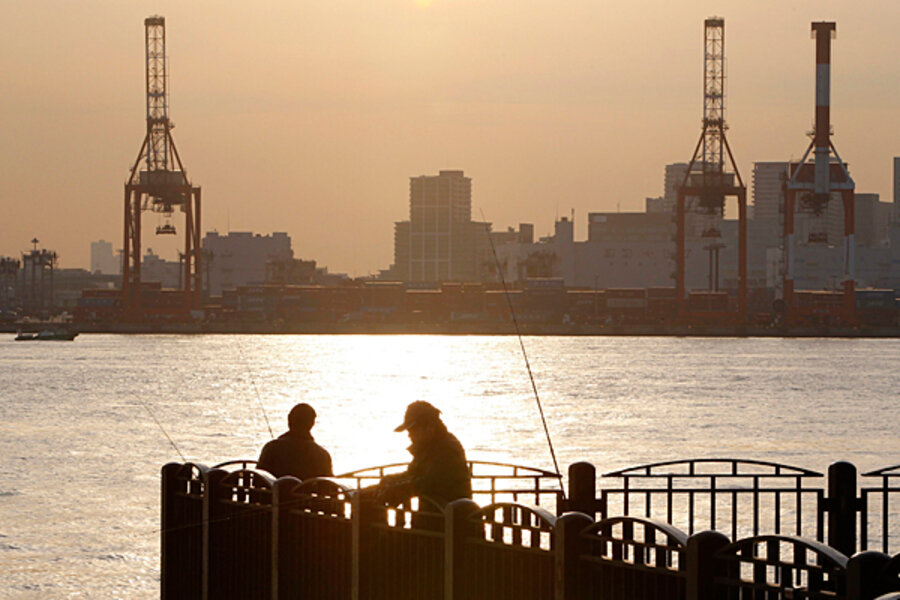What the Japan crisis means for Asian manufacturing hub
Loading...
| Jakarta, Indonesia
Across East Asia, people have been on edge over the risk of deadly radiation spreading from Japan. While that possibility is still remote, the ripples from a severe economic blow to Japan may prove more lasting for developing countries that depend on Japanese trade and investment.
Economists say it’s too early to know the full financial impact of Friday’s magnitude 9.0 earthquake and subsequent tsunami, given the evolving nuclear-plant crisis. However, Barclays Capital has estimated that the total cost could exceed 3 percent of Japanese GDP. This would mean an increased burden on Japan’s government, which is already heavily indebted, and on Japanese companies that must replace destroyed assets.
For Asian exporters, the immediate impact has been a disruption of trade with Japan. This includes multinational companies that rely on sophisticated Japanese components, such as electronic parts, for products that are finished elsewhere. Suppliers of materials to Japan’s giant auto industry have also been affected, with rubber prices falling sharply on fears of a prolonged slowdown.
This immediate crunch is expected to ease, though. Indeed, it may give way to a boom in exports of materials that Japan needs for reconstruction, giving a boost to Asian producers.
This was the pattern seen after the 1995 Kobe quake, says Chatib Basri, an economics professor at the University of Indonesia in Jakarta. “After one quarter, there was an economic recovery because a lot of money was put in by the Japanese government.”
Thailand, Malaysia, and Singapore
Thailand’s central bank echoed this point, arguing that Thailand wouldn’t be badly affected by the quake. In Malaysia, a securities company, CIMB, estimated that a 1 percent drop in Japan’s GDP would shave only 0.2 percent from Malaysia’s economic output. But economists say that exports from Thailand, Malaysia, and Singapore to Japan will definitely take a hit in the short term.
A more long-term worry for countries like Vietnam and Indonesia is whether or not Japanese investment will be diverted by the domestic tragedy. Last year, Japan was the fourth-largest foreign investor in Indonesia and is a major aid donor. It has pledged to support various Indonesian economic projects, including a $24 billion plan to upgrade Jakarta’s creaky infrastructure.
Indonesian government officials have insisted that Japan wouldn’t scale down its commitment to these projects. “So far, everything is still on track, nothing has been delayed,” Economic Minister Hatta Rajasa said on Monday, the Jakarta Post reported.
Strained finances
But economists warn that Japan’s finances, both public and private, could be strained by the earthquake’s impact, particularly if the nuclear crisis leads to greater dependence on other forms of energy, virtually all of which Japan must import.
Japan is a major supplier of capital to much of Asia, so any repatriation of funds would be felt in regional financial markets, says Joseph Zveglich, assistant chief economist at the Asian Development Bank in Manila.
“Funds are likely to be diverted to reconstruction efforts, implying that less capital could be available for investments abroad,” he says.
Manufacturing across Asia
Since the 1980s, Japanese companies have steadily shifted manufacturing to other parts of Asia, seeking to lower their operating costs and tap new markets. Some analysts contend that this trend may accelerate in the wake of the earthquake as companies try to lessen their reliance on domestic operations.
The quake has also exposed the drawbacks to Japan’s “just-in-time” system for delivering components to factories, a system that relies on reliable transport and communications. While Japanese auto makers source most parts from local suppliers, more sophisticated parts are made in Japan and shipped to plants in countries like China and Thailand.
Andrew Stotz, head of research at Kim Eng Securities in Bangkok, says Japanese companies may have to tread carefully in expanding in markets like Thailand, which has been courting Japanese investors in industrial zones.
“There’s politics and nationalism that will be in play, if Japanese companies try to shift to Thailand instead of rebuilding at home,” he warns.
Indonesia should receive continued support from Japan in the form of concessionary loans for major projects, says Mr. Chatib, who is an informal adviser to Indonesian President Susilo Bambang Yudhoyono. He points out that Japanese aid wasn’t cut after the 2008 global recession, even though Japan’s finances were strained at the time.
“It’s not because they love us so much, it’s because their economic interests are at stake in Indonesia,” he says.





